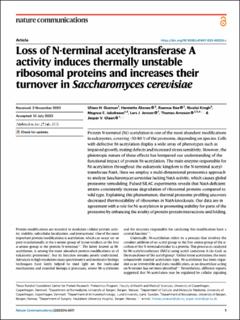| dc.contributor.author | Guzman, Ulises H. | |
| dc.contributor.author | Aksnes, Henriette | |
| dc.contributor.author | Ree, Rasmus | |
| dc.contributor.author | Krogh, Nicolai | |
| dc.contributor.author | Jakobsson, Magnus | |
| dc.contributor.author | Jensen, Lars J. | |
| dc.contributor.author | Arnesen, Thomas | |
| dc.contributor.author | Olsen, Jesper V. | |
| dc.date.accessioned | 2023-10-09T08:19:46Z | |
| dc.date.available | 2023-10-09T08:19:46Z | |
| dc.date.created | 2023-10-02T12:38:58Z | |
| dc.date.issued | 2023 | |
| dc.identifier.issn | 2041-1723 | |
| dc.identifier.uri | https://hdl.handle.net/11250/3095165 | |
| dc.description.abstract | Protein N-terminal (Nt) acetylation is one of the most abundant modifications in eukaryotes, covering ~50-80 % of the proteome, depending on species. Cells with defective Nt-acetylation display a wide array of phenotypes such as impaired growth, mating defects and increased stress sensitivity. However, the pleiotropic nature of these effects has hampered our understanding of the functional impact of protein Nt-acetylation. The main enzyme responsible for Nt-acetylation throughout the eukaryotic kingdom is the N-terminal acetyltransferase NatA. Here we employ a multi-dimensional proteomics approach to analyze Saccharomyces cerevisiae lacking NatA activity, which causes global proteome remodeling. Pulsed-SILAC experiments reveals that NatA-deficient strains consistently increase degradation of ribosomal proteins compared to wild type. Explaining this phenomenon, thermal proteome profiling uncovers decreased thermostability of ribosomes in NatA-knockouts. Our data are in agreement with a role for Nt-acetylation in promoting stability for parts of the proteome by enhancing the avidity of protein-protein interactions and folding. | en_US |
| dc.language.iso | eng | en_US |
| dc.publisher | Nature | en_US |
| dc.rights | Navngivelse 4.0 Internasjonal | * |
| dc.rights.uri | http://creativecommons.org/licenses/by/4.0/deed.no | * |
| dc.title | Loss of N-terminal acetyltransferase A activity induces thermally unstable ribosomal proteins and increases their turnover in Saccharomyces cerevisiae | en_US |
| dc.type | Journal article | en_US |
| dc.type | Peer reviewed | en_US |
| dc.description.version | publishedVersion | en_US |
| dc.rights.holder | Copyright 2023 The Author(s) | en_US |
| dc.source.articlenumber | 4517 | en_US |
| cristin.ispublished | true | |
| cristin.fulltext | original | |
| cristin.qualitycode | 2 | |
| dc.identifier.doi | 10.1038/s41467-023-40224-x | |
| dc.identifier.cristin | 2180912 | |
| dc.source.journal | Nature Communications | en_US |
| dc.identifier.citation | Nature Communications. 2023, 14 (1), 4517. | en_US |
| dc.source.volume | 14 | en_US |
| dc.source.issue | 1 | en_US |

